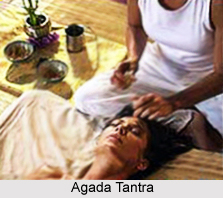 Agada Tantra is a specialized branch of Ayurveda that offers us meticulously detailed information about the non- animal ( sthavar) and animal (jangam) poisons (visha) and the methods of elimination of these poisons from the human body. It particularly advocates different antidotes for materials which are poisonous to the human body. The branch of Agada Tantra finds explicit mention in Charak Sanhita, Sushruta Sanhita and Sharangdhar Sanhita. Uttar Sthana, the sixth section of Ashtang Ayurved, a mammoth book written by the eminent sage Vagbhata Rishi has a total of 40 adhyayas (chapters). Out of these 40 adhyaya, 4 adhyaya discuss Agada Tantra or visha tantra (toxicology and forensic medicine). It can be said that these 4 adhyaya are the essence of all ancestral sanhitas and they are adequate to give us a comprehensive idea about this particular branch of Ashtang ayurved.
Agada Tantra is a specialized branch of Ayurveda that offers us meticulously detailed information about the non- animal ( sthavar) and animal (jangam) poisons (visha) and the methods of elimination of these poisons from the human body. It particularly advocates different antidotes for materials which are poisonous to the human body. The branch of Agada Tantra finds explicit mention in Charak Sanhita, Sushruta Sanhita and Sharangdhar Sanhita. Uttar Sthana, the sixth section of Ashtang Ayurved, a mammoth book written by the eminent sage Vagbhata Rishi has a total of 40 adhyayas (chapters). Out of these 40 adhyaya, 4 adhyaya discuss Agada Tantra or visha tantra (toxicology and forensic medicine). It can be said that these 4 adhyaya are the essence of all ancestral sanhitas and they are adequate to give us a comprehensive idea about this particular branch of Ashtang ayurved.
Agada Tantra deals with a wide range of natural poisons or toxins produced by members of the animal kingdom (mammals, reptiles, insects, etc.) and poisonous substances from plants or herbs (belladonna, aconite etc.). This branch also includes information on how to tackle poisonous substances derived from minerals and metals (lead, mercury, arsenic, copper, etc.) and artificial poisoning from drugs. Agada Tantra insists that substances which are `drugs` when administered in the correct dose may become poisons when taken in overdose. This branch provides information regarding fatal doses of various poisons, which when administered into an enemy`s body system cause death.
 Agada Tantra also deals with the toxic effects of different substances from air, water and food. Polluted air, contaminated water and unhygienic or contaminated or stale food can cause poisoning in the human body. In addition to this , they may also result in the spread of epidemics in a society . Ayurved has a detailed description of the causes and treatment for food poisoning. It enlists different types of foods that are safe when taken separately but act as poison when consumed together. Agada Tantra says that meat from animals, birds and aquatic animals turns into poison if cooked or consumed with phaseolus radiatus, honey, milk, sprouted legumes or jaggery. Moreover, chicken and curd act as poison when eaten together . Few types of food, when consumed in very large amount, act as poison and harm the body. Excess consumption of chilies, spices and mustard oil results in irritation in the digestive tract and eventually shows effects similar to that of a toxin.
Agada Tantra also deals with the toxic effects of different substances from air, water and food. Polluted air, contaminated water and unhygienic or contaminated or stale food can cause poisoning in the human body. In addition to this , they may also result in the spread of epidemics in a society . Ayurved has a detailed description of the causes and treatment for food poisoning. It enlists different types of foods that are safe when taken separately but act as poison when consumed together. Agada Tantra says that meat from animals, birds and aquatic animals turns into poison if cooked or consumed with phaseolus radiatus, honey, milk, sprouted legumes or jaggery. Moreover, chicken and curd act as poison when eaten together . Few types of food, when consumed in very large amount, act as poison and harm the body. Excess consumption of chilies, spices and mustard oil results in irritation in the digestive tract and eventually shows effects similar to that of a toxin.
Some types of food prepared or kept in iron or copper utensils turn into poison. For instance, buttermilk or other sour preparations when kept in a copper container for a long time, undergoes transformation into a substance injurious to health according to Agada Tantra. Thus Agada Tantra insists that food substances cause severe or chronic poisoning if the means of their preparation or storage is defective .
Agad Tantra holds that certain potentially poisonous substances such as mercury and lead can be used as medicines if properly processed under the supervision of ayurvedic scholars and applied in the prescribed dose. Tracing this path shown by Agad Tantra , today we have many medicines available in combination with mercury. This branch of ayurvedic medicine and pharmacology is well known by the name rasa shastra and parad kalpa. Agad Tantra also postulates that expensive stones like diamonds and valuable metals that are not palatable to the human beings thus are toxins for a healthy body can be processed and used in powdered form in certain urgent necessities .
Summarily , we can say that Agad Tantra or visha tantra is that branch of Ashtang Ayurved which deals with various natural and artificial toxic substances and poisons in detail, along with their antidotes and curative procedures. This branch is very important in the sense that it purges the body from poisons which might otherwise prove fatal.




















